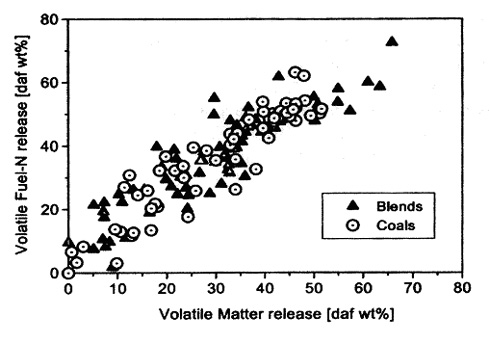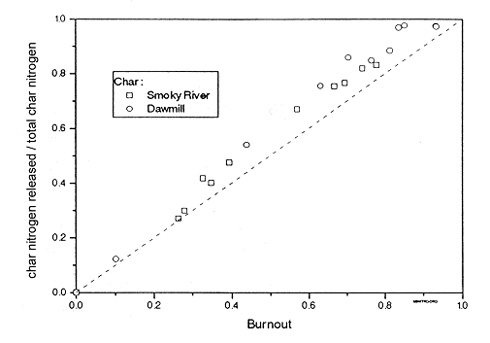-
How may the IFRF Isothermal Plug Flow Reactor be used to characterise the fate of fuel nitrogen for pulverised fuel?
Date posted:
-
-
Post Author
dev@edge.studio
1. Background
Increasingly more stringent environmental legislation, together with the tendency towards the use of coals of different grades and non-fossil substitute fuels for power generation, makes fuel characterisation of extreme importance. One important point of concern is [GLOSS]NOx[/GLOSS] emissions. Three different NOx formation paths are known and well investigated: thermal, prompt and fuel NOx (CF41, CF42, CF66, CF125). The latter path is highly dependent on the fate of fuel-nitrogen (fuel-N), i.e. the partitioning between fuel-N released during [GLOSS]devolatilisation[/GLOSS] and fuel-N released during [GLOSS]char[/GLOSS] combustion. The knowledge of volatile/char-N is a very important parameter for the design of Low-NOx burners and for the prediction of NOx emissions with CFD models.
Measurements in the IFRF Isothermal Plug Flow Reactor (IPFR) can be used to characterise the fate of fuel-N of coals, non-fossil substitute fuels and their blends under conditions found in industrial boilers.
2. Fuel-nitrogen release
Fuel-nitrogen release during devolatilisation
The fraction of fuel-N released during devolatilisation has great importance for the design of Low-NOx burners as the volatile-N can be reduced to molecular nitrogen under reducing (sub-stoichiometrical) conditions.
Isothermal Plug Flow Reactor measurements allow the fate of fuel-nitrogen released during pyrolysis to be traced. This is done by analysing the nitrogen content of solid samples taken during devolatilisation experiments and performing a mass balance for nitrogen, yielding [1]:
|

|
Eq. (1) |
where VN = fraction of volatile fuel nitrogen [wt.-% daf]
VM = volatile matter [wt.-% daf]
Nact = fuel-N content found in the pyrolysed sample [wt.-% dry]
Nini = fuel-N content of the initial fuel [wt.-% dry]
Figure 1 shows the measured volatile fuel nitrogen fraction over the weight loss during devolatilisation for several coals and their blends.
It was concluded that fuel-nitrogen release is a [GLOSS]non-additive property[/GLOSS][2] of fuel blends underlining the necessity of measurements.

Figure 1: Measured volatile fuel nitrogen fraction of pure coals and coal blends
Fuel-nitrogen release during char combustion
Applying the same principals described above, fuel-nitrogen release can be measured by determining the nitrogen fraction of char samples. Equation (1) can be re-written in a more general form, yielding:
|

|
Eq. (2) |
where NR denotes the nitrogen fraction released in [wt.-% N daf] and ashini and ashact are the initial and actual ash contents of the fuels, respectively.
Figure 2 shows measurements of char-nitrogen releases for two different coal chars.

Figure 2: Nitrogen evolution during char burnout
It was concluded that the nitrogen evolution during both devolatilisation and char burnout is proportional to the rate of devolatilisation or combustion, respectively [2], but the absolute values of fuel-N release cannot be predicted a priori.
3. Conclusions
The fate of fuel-nitrogen can be assessed using the IFRF Isothermal Plug Flow Reactor for both devolatilisation and char burnout. Previous studies showed that the fuel-nitrogen release is proportional to the rate of devolatilisation or combustion, respectively, but the absolute values of fuel-N released cannot be predicted a priori. Furthermore it was shown that the fate of fuel-nitrogen of blends does not follow the additivity rule.
Acknowledgements
The author would like to acknowledge the contributions of a long list of IFRF investigators who have worked to develop this reactor during the last fifteen years.
Sources
[1] Haas, J., Tamura, M., Weber, R. : Characterisation of coal blends for pulverised fuel combustion, Fuel 80 (2001) pp. 1317 – 1323
[2] Haas, J., Maalman, T., Gallagher, G.,: Pulverised fuel combustion characterisation of coal blends, IFRF Doc No F37/y/38, 1997
